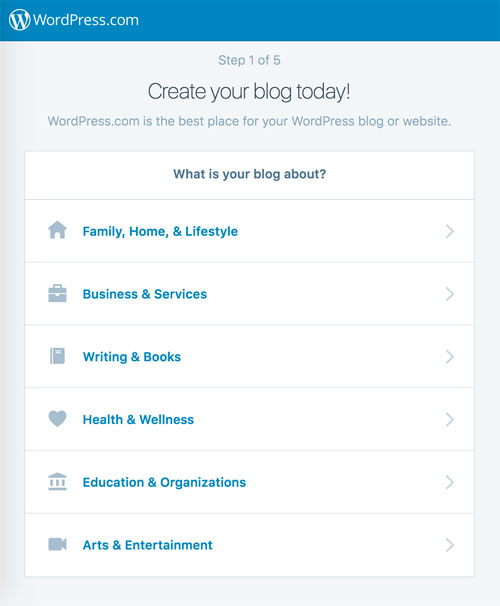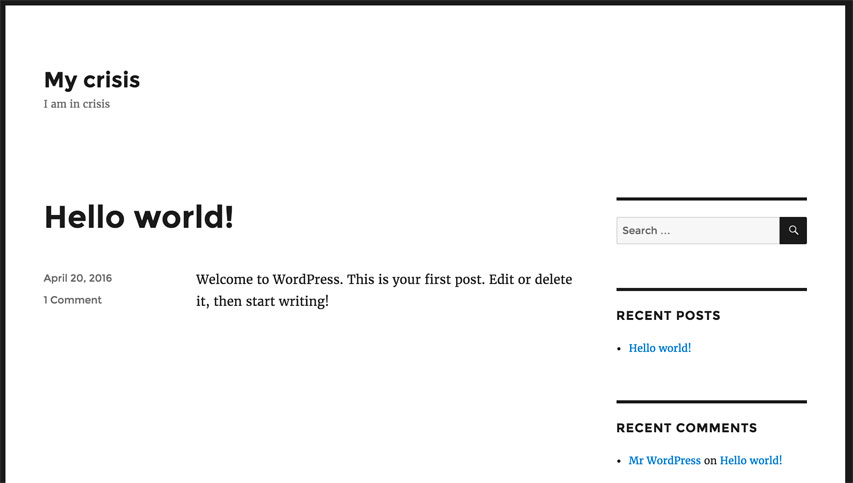One of the selling points for (the free software that is) WordPress is its user friendliness. Intuitive, accessible, open—all of these words are at the root of what WordPress is and why it is of such benefit to the publishing world. I largely agree with this.
That said, I know I am an insider (albeit peripherally) to the WordPress community, so need to remember that I am an unreliable narrator. Still, inspired by the wonderful book “Design for Real Life“ by Sara Wachter-Boettcher and Eric Meyer, I’m taking a critical eye to my CMS of choice. Comprised of examples of developer choices in language and quirkiness that hurt people in real-life, the book’s thesis aims to shift design thinking toward creating technology that is less assumptive, less witty, and therefore, less alienating.
In choosing to examine WordPress—specifically its onboarding process—I’m not out to indict the product in any way. I know WP well, make my living from it, and honestly, when something powers a huge chunk of the internet, there exists the most potential to influence the web dev industry through leading by example.
When it comes to the average WordPress user, not everyone who wants to publish content is a cat blogger or someone with a new theory on the shared Pixar universe. Some people—possibly a great number of them—are people in crisis. Perhaps it is someone who was abused and needs an outlet for their pain. Maybe a person recently lost a loved one and wishes to serially eulogize them. Whatever the reason, the question is: Does WordPress democratize the publishing experience for all, or only for those tonally similar to its light-hearted voice?
WordPress.com
In placing myself in the mind of someone without WordPress experience who is also dealing with trauma, odds are they would turn to the free WordPress.com. If I ignore the homepage choices and click directly on the (appropriately) neutral Create Website button, I am immediately forced into a choice:

One trend you’ll see throughout my review is that it seems developers equate accessible technology with enthusiasm, so a lot of microcopy is not made up of statements, but rather of shouted phrases, complete with copious exclamation points. Create your blog today! I am…told? Encouraged to do? Instructed? Whether this lead-in is an excited statement of support or a forceful edict, I’m not sure a person-in-crisis needs a commander nor a cheerleader.
What is my blog about? Well, I’m not sure these categories map well to my imagined persona. My crisis might be attached to a family member (losing one I love or being hurt by one I hate) or wellness (and lack thereof) but really, my crisis-self just wants to start typing. This decision tree siloing feels extraneous and disruptive.
But say we make a choice of category. Moving on, the next page is a series of SUBcategories! You can’t skip any of these, by the way, so a choice must be made regardless of how accurate it reflects reality. I’m going to assume that these choices drive both presented theme options (though many categories seem to have the same few suggested themes) as well as discoverability / cross-promotion within the broader WordPress.com ecosystem. Neither really matters to someone who just wants to get stuff out of their head, but again, the choices are forced.
Once I choose my overarching category and attendant subcategory, I have completed Step 1 of 5 of the WordPress.com onboarding process. Seriously, all that is just 20% of what is expected of a new user. Luckily, theme selection, which is the next step, can be skipped over at least.
Hello, World
At this point, we can shift examination to include both a free WordPress.com site and a self-hosted one derived from WordPress.org.
The site I set up for this crisis article uses the on-the-nose title My crisis because WordPress forces you to name your site when you install / create it, which programmatically makes sense. I also was forced to make a site description, so complied with the on topic I am in crisis. Lastly, I opted to use the Twenty Sixteen theme because, with no other themes installed, this is the current default look and arguably shows what Automattic thinks a baseline theme should be nowadays.

Again, our person-in-crisis is immediately yelled at with a few exclamatory content pieces. Why is technology always defaulting to a pep rally? Who has school spirit? We do!
Every WordPress installation ships with a few placeholder content elements, serving as examples of posts, pages, and comments. The sample post and comment each use the same phrasing—Hello world!—a callback to a 40+ year old programming tradition. The problem I have with many traditions is, if scrutinized, defenders will default to the circular argument of “it’s tradition” as a reason to keep using said tradition. Definitions of marriage, names for sports teams, and many other issues rely upon tenure as a reason to buck change, ignoring the current world. Tradition isn’t enough reason to do a thing or to not do a different thing.
A person-in-crisis has gotten their WordPress site up and running and the first order of business is to delete a few Hello worlds! that, at the start, dominate their site. What if they are writing to mourn a loved one who just departed the world? What if they are struggling with processing a miscarriage, a suicide, or a murder? These examples may not be the majority, but the off-hand decision to pay homage to a traditional programming test text could hold unforeseen, detrimental reactions for some. There are more conscious ways to demonstrate posts and comments than what is currently done.
The man in the machine
Apart from that, the big thing that jumps out at me is the default commenter for new WordPress sites. Quite frankly, the vast majority of blogs (mine included) fail to draw significant amounts of comments, at least within their own commenting systems. But WordPress ships with a shiny comment right out of the gate, loudly(!) delivered by Mr WordPress.
Mr WordPress, using its honorific as a guide, is a male entity. In an industry dominated by men, Automattic makes sure that every installation of WordPress has a guy hanging out inside it, ready to shout Hello world! from a site’s inception. Again, what if the crisis our site creator is dealing with is abuse from a man? Sexual violence from a man? Literally any trauma originating from the male gender? It seems like an arbitrary decision that Mr WordPress lives on.
Every mascot does not need to be genderless to be acceptable—personally, I think Tony the Tiger is grrreat and Mr Met is a real class act—but why draw the distinction of gender for this asexual product? He could easily be replaced with the genderless wapuu, or even something more literal, yet nonspecific, like Commenter.
I have no doubt that Automattic is NOT trying devilishly to push some brogramming culture nonsense. I could see Mr WordPress being an innocent, joking homage to Spaceballs and its Mr Coffee / Mr Radar scene, but the issue doesn’t take a heap of effort to dissect and find concerning. Every time someone installs WP, the first recognition their site gets is from a masculine persona. It would be so easy to change this, and yet Mr WordPress lives on and on and on, possibly as the most prevalent blog commenter on the planet.
Be excited without being exclusionary
I’m not saying that all technology has to be sterilized to the point of Hal 9000-ness, but often, the human touches added to technology to make them more engaging end up doing the opposite when poked a bit. Just like when Siri (and other digital assistants) would reply to statements like someone saying they want to shoot themselves with directions to the nearest gun store, developers think witty equals welcoming, so technology is given a class clown personality.
To downgrade crisis to something more common, think about when you’re stressed out by everyday life. When you have a need, who do you want to help you: a joking jester or a competent professional? When you called 911 because your house is burning down, do you want the firefighters who arrive to greet you with Hot enough for ya? When you cut your finger at work and, bleeding, ask your cubicle mate where the first aid kit is, would the most welcome reply be Bloody hell, you’re a cut above the rest! or would you just like the damn information you need without a wink and a nod? Why do our digital assistants all have to carry a joking tone of delight and mirth?
Being human doesn’t mean being quippy 24/7. When we’re in need, we want empathy, not enthusiasm. So the next time you are crafting microcopy for an app or site or user journey, take the time to argue with yourself. Look at the words you typed and read them through someone else’s eyes.
Being inclusive is not about being politically correct; it’s about being self-aware enough to know when your language is welcoming people in, or turning them away. Rather than cracking wise, maybe all we need from technology is a helpful listener, and a direct responder.